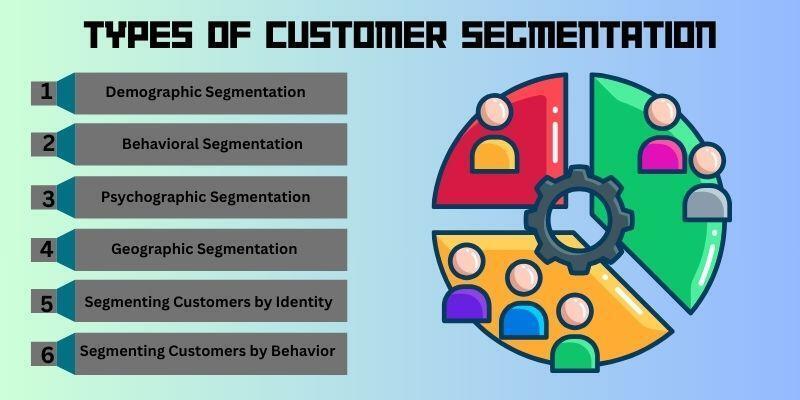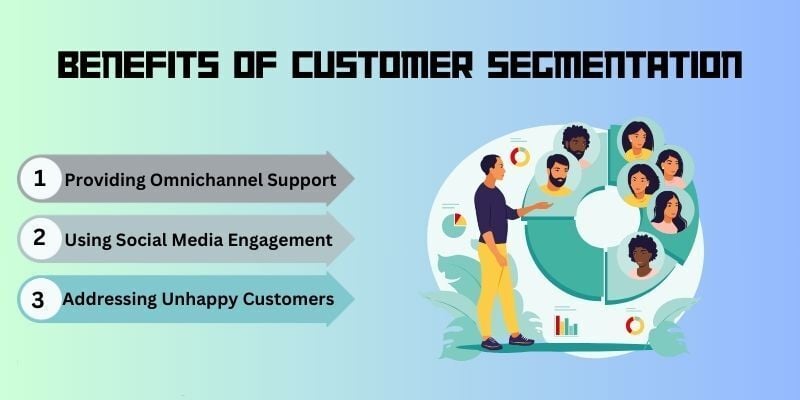In today’s highly competitive business environment, understanding your customers is more important than ever.
A one-size-fits-all approach to marketing no longer works, as consumers expect personalized experiences that resonate with their specific needs and preferences.
This is where customer segmentation comes into play. Businesses can create more targeted marketing strategies and improve overall customer engagement when dividing their customer base into distinct groups, each with shared characteristics such as demographics, behaviors, or values.
Customer segmentation enables companies to tailor their products, services, and communications to fit the unique needs of each segment, which can lead to stronger customer relationships and increased brand loyalty.
Moreover, businesses can use these insights to identify high-value customers, optimize marketing budgets, and improve the overall customer experience.
In this article, we will explore the concept of customer segmentation, its various types, its benefits, and how it can drive profitability by helping businesses stay more attuned to their customer base.
What is Customer Segmentation Analysis?
Customer segmentation analysis is a strategic approach that enables businesses to identify distinct groups of customers based on shared characteristics.
This analysis aims to divide a company’s customer base into segments that can be targeted with tailored marketing and service strategies.
When businesses group customers with similar needs, behaviors, or preferences, they can create more personalized experiences and increase customer engagement.
This process helps companies understand the diverse needs of their customers, allowing them to fine-tune their offerings. For example, a retail company might use customer segmentation analysis to identify different shopping behaviors among their customer base.
One segment may prefer buying luxury items, while another might be more price-conscious. When understanding these differences, the business can tailor its marketing campaigns to speak directly to each group.
Conducting customer segmentation analysis also gives businesses valuable insights that can inform decisions on product development, marketing strategies, and even customer service enhancements.
For instance, a company may find that a specific segment prefers faster delivery services, leading them to offer express shipping options to improve customer satisfaction.
In today’s competitive market, identifying customer segments is crucial for staying relevant. Businesses that can tap into their customer segments’ specific needs and preferences are better equipped to deliver personalized experiences that drive loyalty and long-term profitability.
What is Customer Segmentation?
 Customer segmentation is the process of dividing a broad customer base into smaller groups that share similar characteristics.
Customer segmentation is the process of dividing a broad customer base into smaller groups that share similar characteristics.
These customer segments are based on demographics, behaviors, or preferences, allowing businesses to tailor their marketing and customer service approaches to meet the specific needs of each group.
By defining and understanding each segment’s unique traits, businesses can move away from a generic, one-size-fits-all approach and instead deliver personalized messaging and offers.
For example, a brand targeting millennials and older generations would benefit from segmenting these groups based on their digital habits and product preferences. While millennials prefer engaging with brands on social media, older customers may be more responsive to email campaigns.
Segmenting customers allows businesses to refine their marketing efforts and increase efficiency. Instead of casting a wide net and hoping to reach potential customers, companies can focus on specific segments more likely to engage with their brand.
This targeted approach leads to higher conversion rates and a more personalized experience for the customer.
Customer Segmentation vs. Market Segmentation
Although customer and market segmentation may sound similar, they are distinct concepts that serve different purposes within a business’s strategy.
Customer segmentation focuses on breaking down a company’s existing customer base into smaller, more manageable segments. These groups can be targeted with specific offers, services, or marketing campaigns tailored to their needs.
On the other hand, market segmentation involves dividing a broader target market into smaller groups based on specific characteristics, such as age, location, or lifestyle.
This strategy is primarily used to identify potential new customers who share similar traits and might be interested in a company’s products or services.
Customer segmentation zeroes in on existing customers, helping businesses understand their behaviors, preferences, and needs. Meanwhile, market segmentation looks at the broader market and helps companies determine which segments to target with their marketing efforts.
For example, an e-commerce business might use customer segmentation to identify loyal customers who regularly purchase from their store and offer exclusive discounts to develop loyalty.
Simultaneously, they may use market segmentation to identify new potential customers in different regions and run ad campaigns to attract them to the brand.
Types of Customer Segmentation
There are several ways to segment customers, and the right method depends on a company’s goals and available data. Businesses often use one or a combination of the following segmentation types to gain deeper customer insights.
1. Demographic Segmentation
This is the most common type of customer segmentation, where customers are divided based on age, gender, income, education level, and occupation.
Demographic segmentation helps businesses understand the general makeup of their customer base, allowing them to tailor products and services to specific groups.
For example, a company selling high-end skincare products may target women aged 30-50 with a higher income bracket, as they are more likely to invest in premium beauty items.
Similarly, a tech company may target younger consumers who are more tech-savvy and interested in the latest gadgets.
2. Behavioral Segmentation
Behavioral segmentation focuses on how customers interact with a brand. This method divides customers based on their buying behavior, product usage, or loyalty to a brand.
Businesses can gain insights into the purchasing patterns of different customer groups, such as frequent buyers, first-time customers, or those who only purchase during promotions.
When analyzing customer behavior, businesses can develop targeted marketing strategies. For instance, a brand might offer loyalty rewards to regular customers, encouraging repeat business.
3. Psychographic Segmentation
This type of segmentation is based on customers’ lifestyle choices, values, interests, and personality traits. Psychographic segmentation allows businesses to understand the motivations behind customer decisions, helping them create more emotionally resonant campaigns.
For example, a fitness brand may target health-conscious consumers who prioritize wellness and self-care.
By understanding this segment’s values and lifestyle, the brand can tailor its messaging to promote products that align with the customer’s goals of leading a healthy lifestyle.
4. Geographic Segmentation
Geographic segmentation divides customers based on location, country, city, or even climate. This method benefits businesses with a global or regional presence, as customer needs can vary significantly depending on geography.
For instance, a clothing retailer may promote warm-weather clothing in tropical regions and winter apparel in colder climates. Recognizing the geographic location of their customer base allows businesses to offer relevant and appealing products to different markets.
5. Segmenting Customers by Identity
Segmenting customers based on their identity involves looking at demographic and psychographic factors. This method helps businesses understand who their customers are on a personal level, which is crucial for delivering personalized experiences.
For example, demographic segmentation focuses on tangible characteristics like age and income, while psychographic segmentation delves deeper into a customer’s values and interests.
When these two methods are combined, businesses can gain a comprehensive view of their customer segments, allowing them to craft targeted marketing strategies that resonate on both a practical and emotional level.
6. Segmenting Customers by Behavior
Behavioral segmentation focuses on how customers interact with a brand. When dividing customers based on their actions, businesses can target specific behaviors, such as purchasing frequency, brand loyalty, or product usage patterns.
For example, a subscription-based service might segment its customer base into groups based on engagement levels—one segment might include long-term subscribers who rarely engage, while another might consist of new subscribers who frequently use the service.
This type of customer segmentation enables businesses to create personalized strategies for each group, such as loyalty programs for frequent buyers or re-engagement campaigns for inactive users.
When studying customer behavior, companies can better predict future buying patterns and develop strategies to improve customer retention.
This method is particularly effective in identifying high-value customers likely to make repeat purchases, allowing businesses to allocate resources to retain these valuable segments.
The Importance of Customer Segmentation
Customer segmentation is crucial for businesses that want to stay competitive and responsive to changing market dynamics. Without it, companies risk treating all customers the same, which can lead to missed opportunities for personalization and customer satisfaction.
Here are some key reasons why customer segmentation is essential:
- Improving brand loyalty and customer lifetime value: When segmenting customers based on their preferences and behaviors, businesses can create customized offers and experiences. This personalization builds stronger relationships and encourages customers to stay loyal to the brand, increasing their lifetime value.
- Delivering personalized experiences at scale: In a world where customers expect personalized interactions, segmenting customers allows businesses to meet these expectations. Personalized marketing, recommendations, and offers can be delivered to specific segments, resulting in better engagement and higher conversion rates.
- Staying responsive to changing customer needs: Customers’ needs and preferences evolve over time. When continuously analyzing customer segments, businesses can stay agile and adapt their products, services, and marketing strategies to meet changing demands. This ensures they remain relevant and competitive in their industry.
- Greater marketing efficiency: Businesses can optimize their marketing efforts when targeting specific customer segments. Instead of casting a wide net with generalized campaigns, they can focus on delivering relevant content to the right audience, which leads to better results and a higher return on investment.
Benefits of Customer Segmentation
Implementing customer segmentation provides numerous benefits for businesses. Some of the key advantages include:
- Better targeting in marketing campaigns: Segmentation allows businesses to understand which groups of customers are most likely to respond to specific marketing messages. This means that campaigns can be more focused, reducing waste and improving the chances of success.
- Improved customer satisfaction and retention: Customers who feel understood and valued are likelier to remain loyal to a brand. Customer segmentation helps businesses deliver the personalized experiences that drive customer satisfaction, ultimately improving retention rates.
- Increased profitability: Businesses can improve their conversion rates and generate more revenue when targeting customers with suitable offers. For example, a company may use value-based segmentation to identify high-spending customers and offer exclusive promotions, increasing sales and customer loyalty.
- Product development insights: Segmenting customers also provides valuable insights into product preferences. When analyzing the needs of different customer segments, businesses can develop products and services that cater to these preferences, leading to higher satisfaction and better sales performance.
How to Effectively Segment Customers?
Successfully segmenting customers requires a systematic approach. Here’s a step-by-step guide on how businesses can conduct a practical customer segmentation analysis:
- Accessing customer data: The first step is gathering customer data, which can be done through direct methods (surveys, feedback) or indirect methods (purchase history, website analytics). This data forms the foundation for understanding customer behaviors and preferences.
- Identifying common characteristics: Once data is collected, businesses must identify patterns or common customer characteristics. This includes demographic information, buying behaviors, and psychographic traits like lifestyle preferences.
- Creating detailed customer segments: Businesses can create customer segments that represent different groups based on the insights gathered. Each segment should have distinct traits that set it apart from the others. For example, one segment may consist of younger customers who prefer shopping online, while another may include older customers who prefer in-store purchases.
- Personalizing marketing efforts: After identifying segments, the next step is to tailor marketing efforts to each group. This could involve personalized email campaigns, special promotions, or even targeted content on social media that resonates with each segment’s needs.
- Monitoring and refining segments: Customer segmentation is not a one-time task. Businesses should continuously monitor their segments to remain relevant as customer behaviors change. This allows for ongoing refinement of segmentation strategies to keep up with evolving market trends.
Creating Comprehensive Customer Segments
Developing affluent, comprehensive customer segments requires businesses to go beyond basic characteristics. When analyzing multiple data points, companies can create segments that provide deeper insights into customer motivations and preferences.
For instance, a retailer may combine behavioral and psychographic segmentation (purchase frequency) (lifestyle preferences) to create more defined segments.
This holistic approach allows businesses to better understand each group’s unique needs and deliver more targeted marketing strategies.
The key to successful segmentation is understanding the factors driving customer decisions. When combining various types of data, businesses can create segments that are not only accurate but also actionable.
Personalizing Interactions to Close Experience Gaps
One of the main goals of customer segmentation is to personalize customer interactions and close the gaps between what customers expect and what they experience. Businesses can tailor their communications and offers to align with customer preferences when using segmentation insights.
For example, a business might identify that a certain segment prefers personalized product recommendations based on past purchases.
When delivering these recommendations through email or on the company’s website, businesses can boost the customer experience and build stronger relationships.
Closing experience gaps is essential for improving customer satisfaction and loyalty. When customers feel that a brand understands their needs and offers relevant solutions, they are likelier to remain loyal and make repeat purchases.
Driving Profits with Customer Segmentation Analysis
Effective customer segmentation analysis can be a powerful driver of profitability for businesses. When understanding customer groups’ different needs and preferences, companies can optimize their marketing, sales, and product strategies to achieve better results.
For example, a clothing retailer might use value-based segmentation to identify its most profitable customers—those who make frequent, high-value purchases.
By offering these customers exclusive promotions or early access to new products, the retailer can increase sales and foster greater loyalty.
Businesses that leverage customer segmentation systems to their full potential often see significant revenue and customer satisfaction improvements. These systems enable companies to deliver personalized marketing at scale, ensuring every customer feels valued and understood.
FAQs
What are the 4 types of customer segmentation?
The four main types of customer segmentation are demographic, behavioral, psychographic, and geographic.
What is meant by consumer segments?
Consumer segments refer to customers with similar characteristics, such as age, behavior, or preferences, allowing businesses to target them with personalized marketing.
What is an example of a customer segment?
An example of a customer segment could be a group of tech-savvy millennials who frequently purchase electronics online. Businesses can target this segment with digital ads for the latest tech products.
What 4 ways can customers be segmented?
Demographics, behavior, psychographics, and geography can segment customers.
How do we identify key customer segments?
Businesses should collect and analyze customer data to identify customer segments and find patterns and common characteristics. This can include purchase history, preferences, and behaviors.
Conclusion
Customer segmentation is a critical strategy for businesses looking to improve their marketing efforts, increase customer satisfaction, and drive profits.
When using segmentation to identify different customer segments, companies can tailor their messaging, products, and services to meet the unique needs of each group.
Through demographic segmentation, behavioral segmentation, or value-based segmentation, businesses that invest in understanding their customers will be better positioned for long-term success.
As the market continues to evolve, staying responsive to the needs of different customer groups is more important than ever.
Businesses can close the experience gaps, improve engagement, and build stronger customer relationships when utilizing customer segmentation systems.
BOOK A FREE DEMO







